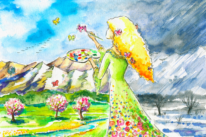
“Why compare yourself with others? No one in the entire world can do a better job of being you than you.” ~Unknown
For fifteen years I gave up on art.
I’d been an “artistic” kid, always drawing and painting, but by first or second grade I was already comparing my work to that of other kids and judging it as inferior.
At thirteen I quit making art altogether. There were other kids who could draw so much more realistically than I could—kids to whom anything artistic just seemed to come naturally—and I jumped to the conclusion that their superior skills meant that they were the artists, and that therefore I wasn’t.
I was the poster child of “compare and despair syndrome,” caught in the comparison trap so badly that the only escape route seemed to be just giving up.
Then fifteen years later, when I was twenty-eight, I found myself fascinated with the art of calligraphy.
I started playing with paper and pens, and it was as if I’d opened a floodgate: soon I was accumulating books and supplies, immersing myself in classes and workshops, rekindling the joy in creating that I’d felt as a young child, before the comparison trap shut me down.
Those harsh self-judgments hadn’t gone away, however.
I’d pore through my calligraphy books and magazines, tears streaming down my face because I just knew my work would never be as good as the pieces on those pages. Every workshop I went to offered more opportunities for comparison with people whose work felt so vastly superior to mine.
I got stuck in the comparison trap so often it’s amazing I managed to make any progress at all.
I remember one workshop in particular, about a year into my calligraphic adventure. The class was all about making decorated initials, and the teacher offered technique after technique to spark our creativity. After each demonstration we’d all race back to our tables to try out what we’d learned.
My comparison trap gremlins—those voices that try to convince me that my work is inferior to everyone else’s—were working overtime.
The woman sharing my work table, Linda, had years of experience under her belt, and the work she was creating showed evidence of her skill and expertise.
Beyond that, though, it was just so creative! The colors she used were so exciting! Her ideas were so cool and interesting!
My own work felt so pathetic in comparison.
Her work inspired me to try new things, but still, nothing I made felt as fresh as what she created. My spirits wavered back and forth between excitement at playing with paper and color, and despair that nothing I created was as beautiful as my table partner’s work.
As the weekend went on, we spread our small exercises out on the floor near our tables so everyone could see the product of our work. With each new addition to our “galleries,” my ego shrunk smaller and smaller, and my negative self-talk got louder.
“Her work is so amazing!” said my gremlins, “Why can’t you make work like that? Your work is so boring!”
Imagine my surprise when Linda turned to me and said, “Melissa, your work is so amazing! My work is so boring—I wish I could make work like yours!”
I was astonished. How could she say that? Her work, boring?
To me, her work was fresh and exciting. But as we talked I realized that what was felt fresh and exciting to me, to Linda felt like the same old stuff she’d been doing forever.
*Click!*
Suddenly, it was as if the world shifted two degrees to the left. Like I was seeing everything through a different lens.
Maybe the truth wasn’t that my work was inferior to Linda’s. Maybe it was simply that her work felt more interesting and exciting to me than my own because it came from her unconscious, her personality, her sensibility—all of which were, of course, totally unknown and mysterious to me.
My own unconscious, personality, and sensibility might not be completely known to me, either, but I know them better than I do anyone else’s, so by definition what springs from me is going to feel less fresh to me than what springs from someone else.
What could I do but laugh? I shared with Linda that I’d been admiring and envying her work all weekend, that I’d tried to emulate her work to make mine more interesting, and she confessed she’d been doing the same on her end, incorporating elements of my work that she particularly liked.
I learned an important lesson that weekend.
I learned that my job is not to judge the value of my creations, but simply to create. My job as an artist is to express me, to pull out the unique expression that can only exist because it’s coming from inside me, and there is only one me.
Your job as a creator is to express you.
Martha Graham said it best, in this quote, which is posted on my wall near my workspace:
There is a vitality, a life force, an energy, a quickening that is translated through you into action, and because there is only one of you in all of time, this expression is unique. And if you block it, it will never exist through any other medium and it will be lost. The world will not have it.
It is not your business to determine how good it is nor how valuable nor how it compares with other expressions. It is your business to keep it yours clearly and directly, to keep the channel open. You do not even have to believe in yourself or your work.
You have to keep yourself open and aware to the urges that motivate you. Keep the channel open. … No artist is pleased. [There is] no satisfaction whatever at any time. There is only a queer divine dissatisfaction, a blessed unrest that keeps us marching and makes us more alive than the others.
~ Martha Graham
I remind myself all the time that it’s not my business to determine how good or valuable my expression is, or how it compares with others. It is my business to keep it mine, to be me—that is where the true value of my creativity lies.
Of course the same is true for you.
Compare and despair syndrome doesn’t only keep us stuck when it comes to creative endeavors, however. It’s easy to get stuck in the comparison trap in all areas of life!
The way someone dresses, their choice of a career or lifestyle, the style of their home décor, their food choices or exercise routine—I’ve stepped into the comparison trap around each and every one of these things and more.
From where I sit, what someone else is doing, the choices they make, can so often seem much more sparkly and fresh than my own life.
What to do? Simply remind myself of what I learned in that workshop with Linda: that other people’s choices will feel more interesting and exciting to me than my own because they come from their unconscious, their personality, their sensibility—all of which are, of course, totally unknown and mysterious to me.
Just like in that workshop with Linda, I allow myself to try things out, using the comparison trap as a gauge to help me experiment and grow. I ask myself: Does this different way of being in the world work for me? Is there something here that I can customize to fit my own needs and desires?
Then I remind myself that, in the end, there’s no comparison. No one in the world can do a better job of being me.
Photo by Marjan Lazarevski
About Melissa Dinwiddie
Melissa Dinwiddie helps people turn their creative taps to "on," and transform their lives from grey to full color. She blogs and podcasts at Living a Creative Life, where you can get a FREE printable poster of her 5 reminders of why creative play is a world-changing act.













 Though I run this site, it is not mine. It's ours. It's not about me. It's about us. Your stories and your wisdom are just as meaningful as mine.
Though I run this site, it is not mine. It's ours. It's not about me. It's about us. Your stories and your wisdom are just as meaningful as mine. 